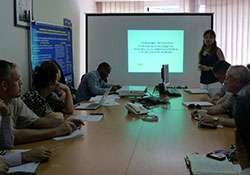Comparison of treatment outcomes, cost and socioeconomic burden for patients in ambulatory versus hospital-based TB care in Tajikistan

WHO/Tahmina Alimamedova
The national tuberculosis (TB) team as well as key international partners involved in the TB programme in Tajikistan met on 31 July 2012 to discuss the main findings and recommendations of an operational research project to compare treatment outcomes.
The study was conducted jointly by Interactive Research and Development (IRD) and Tajikistan's National TB Programme with WHO technical assistance and UNDP financial support provided within the Global Fund to fight AIDS, Tuberculosis and Malaria Round 8 Proposal.
Background
TB remains one of the main public health threats in Tajikistan. The healthcare system has a strong emphasis on hospitalization, a trend inherited from the former Soviet Union; and the National Guidelines on TB Management accordingly recommend that all TB cases be hospitalized during the intensive phase of treatment, after which they can be shifted to ambulatory care through primary health care (PHC) facilities. However, due to hospitals’ technical insufficiency and poor hospital infection control, approximately 50% of patients receive the full course of treatment through the ambulatory care system.
Due to a lack of subsidies during the Soviet era and deteriorating economic conditions, hospitals and PHC facilities in Tajikistan face several challenges. While hospitalization increases the risk of nosocomial transmission and the socioeconomic burden on patients, ambulatory care in PHC centres can be affected by low staff motivation, resulting in poor directly observed therapy (DOT) and hence poor outcomes.
Scope and results of the study
The current study was aimed at comparing TB treatment outcomes at hospital and ambulatory levels in Tajikistan. The research included not only comparison of end-outcome analysis, but also the social and economic burden of TB treatment at both levels.
The main finding of the research suggests that patients treated through the ambulatory model have similar treatment outcomes as hospital-based patients. The ambulatory/community-based model is moreover cheaper than the hospital-based model of care for both the patients and the health system. One of the main recommendations was therefore to advocate treatment of TB patients in the community using the more cost-effective ambulatory model.
The research results will be used by the Ministry of Health of Tajikistan, the National TB Control Programme and international partners to act on improvement of the TB treatment model through better cooperation of different divisions and services, further mainstreaming of PHC involvement, and introduction of standards of care provision based on international recommendations, such as for inpatient treatment and prevention of drug resistance.
For more information contact Dr Sayohat Hasanova, Country Programme Coordinator for STI/HIV/AIDS and TB, WHO Country Office in Tajikistan at hasanovas@euro.who.int.



